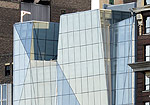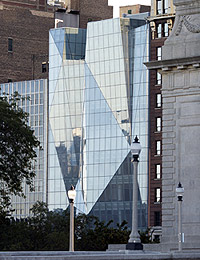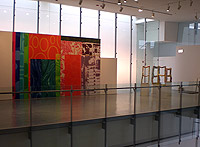|
|
In Chicago, a city with major architectural chops, it’s pretty bold to say that one building “catalyzes the renewal of the Chicago school of architecture.” But, hey, the new Spertus Institute is one bold building, so its president Howard Sulkin (who said that), isn’t far off the mark.
If you want to check it out, it’s at 610 S. Michigan Ave. Doors won’t open to the public until November 30th, but everybody is already talking about it. Consider that it landed on Chicago‘s list of the top 10 masterpieces before construction was even completed; when we did a companion online survey, readers voted it as their favorite building when no one had even been inside.
They opened the doors for a media tour today, and it is truly incredible. I’ll spare you all of the details from the tour and let the pictures do the talking. I was curious, though, about a few things and thought you might be too. So I wrote up some questions that I (or other reporters) asked and paraphrased the answers (from various sources) below.
|
|
Q: Is it LEED-certified (e.g. sustainable)?
A: Yes, it’s a silver rating. I won’t go on and on about what makes it so, but there are some cool energy-saving features built into the curtain wall—or, the front of the building, which is solid glass.
Q: It looks tall and thin; what is the size of the lot?
A: Believe it or not, the lot is only 80 feet wide and 170 feet deep.
Q: Who is the architect?
A: The Chicago firm Krueck & Sexton
Q: What makes this building such a big deal?
A: First off, it is one of the last open spaces on primo Michigan Avenue. Second, the multifaceted curtain wall is made up of 720 panels of glass, which allow light to stream in the building from the east, despite the fact that it is sardine-d by two buildings on the north and south sides.
Q: Is there a weird “only Cassie would be interested in this” fact that you’re going to include?
A: Why, yes, yes there is. If you look closely at the glass, you’ll see hundreds of little dots. Another writer and I were curious about them; is the only purpose they serve to reduce the glare? No, it turns out. The ceramic dots give the glass wall texture, which, in turn, helps birds see the building. An extraordinary number of birds fly into Chicago buildings and die every year. This is a way to curb the birds’ early trips to heaven.
Photography: (Image 1) Steve Lindsey, Courtesy of Spertus Institute of Jewish Studies; (Image 2) Cassie Walker






